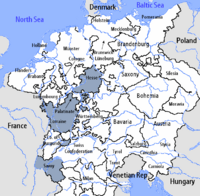Wetzlar
| Wetzlar | |
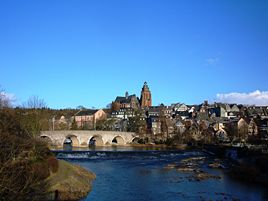 |
|
| Coat of arms | Location |
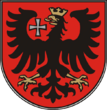 |
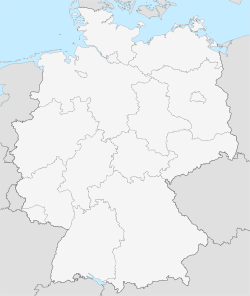 |
| Administration | |
| Country | Germany |
|---|---|
| State | Hesse |
| Admin. region | Gießen (region) |
| District | Lahn-Dill-Kreis |
| Town subdivisions | 8 quarters |
| Lord Mayor | Wolfram Dette (FDP) |
| Basic statistics | |
| Area | 75.67 km² (29.2 sq mi) |
| Elevation | 148-401 m |
| Population | 52,831 (30/06/2006) |
| - Density | 698 /km² (1,808 /sq mi) |
| Other information | |
| Time zone | CET/CEST (UTC+1/+2) |
| Licence plate | LDK |
| Postal codes | 35521–35586 |
| Area code | 06441 |
| Website | wetzlar.de |
| Location of the town of Wetzlar within Lahn-Dill-Kreis district | |
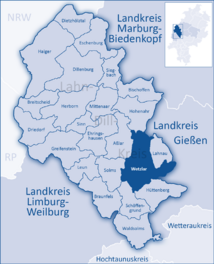 |
|

Wetzlar is a town in the German federal state (Bundesland) of Hesse, capital of the Lahn-Dill district. Located at 8° 30′ E, 50° 34′ N, there are (as of 2002) approximately 54,000 inhabitants. The town is situated on the Lahn river.
Notable architectural features include the Eisenmarkt and the steep grades and claustrophobic street layout of a medieval town. The sandstone cathedral of St. Mary was commenced in the 12th century as a Romanesque building. In the later Middle Ages the construction was continued under a masterplan in Gothic style. The church was never finished, as one steeple still is uncompleted. The cathedral suffered heavy damage in the Second World War by aerial bombing, but was restored in the 1950s. On the outskirts of town exist the ruins of several masonry towers arranged along the river.
Contents |
Geography
Wetzlar lies in the Lahn-Dill area in Middle Hesse on the river Lahn, not far downstream from its change in direction from south to west in the heights near the mouth of the Dill. The town lies at a division between Hessian low mountain ranges: south of the Lahn lies the Taunus; north of the Lahn and west of the Dill begins the Westerwald; north of the Lahn and east of the Dill begins the Rothaargebirge. The highest point within town limits is the Stoppelberg at 401 m above sea level.
Wetzlar's neighbouring towns and cities are Gießen (up the Lahn from centre to centre about 12 km), Koblenz 80 km down the Lahn, Limburg an der Lahn 40 km to the west, Siegen 50 km to the northwest, Dillenburg 30 km to the north, Marburg 30 km to the northeast and Frankfurt am Main 60 km to the south.
Wetzlar and Gießen are the two cores of this small (about 200,000 inhabitants) urban agglomeration in Middle Hesse. Along the valleys of the Lahn (east and west) and Dill (north) are heavily built-up neighbouring communities, whose built-up areas in some places merge with Wetzlar's. The low mountain ranges around Wetzlar to the northwest, northeast and south, on the other hand, are heavily wooded and very thinly populated.
Neighbouring communities
Wetzlar borders in the northwest on the town of Aßlar (Lahn-Dill-Kreis), in the north and northeast on the communities of Hohenahr (Lahn-Dill-Kreis) and Biebertal (Gießen district), in the east on the communities of Lahnau (Lahn-Dill-Kreis) and Heuchelheim and the town of Gießen (both in Gießen district), in the south on the communities of Hüttenberg and Schöffengrund and in the west on the town of Solms (all in Lahn-Dill-Kreis).
Constituent communities

The core area of Wetzlar is divided into 12 urban wards or boroughs (Stadtbezirke). Furthermore, there are 8 communities outside the core area. Five of them have long since been swallowed up in Wetzlar's main built-up area. All, however, became part of Wetzlar with the dissolution of the city of Lahn in 1979.
Below is a chart of all Wetzlar's constituent communities, both within the main built-up area and without, as of[update] 31 December 2005:
| Number | Borough | Population |
|---|---|---|
| 01 | Altstadt | 2,266 |
| 02 | Neustadt | 2,013 |
| 03 | Hauserberg | 1,951 |
| 04 | Büblingshausen | 3,161 |
| 05 | Sturzkopf | 3,332 |
| 06 | Stoppelberger Hohl | 2,552 |
| 07 | Nauborner Straße | 2,237 |
| 08 | Silhöfer Aue | 2,237 |
| 09 | Altenberger Straße | 1,424 |
| 10 | Dalheim | 3,496 |
| 11 | Dillfeld | 0 |
| 12 | Niedergirmes | 5,896 |
| ◇ | Whole town core | 31,022 |
| Number | Community | Population |
| 13 | Hermannstein | 3,650 |
| 14 | Blasbach | 986 |
| 15 | Naunheim | 3,929 |
| 16 | Garbenheim | 2,149 |
| 17 | Dutenhofen | 3,088 |
| 18 | Münchholzhausen | 2,476 |
| 19 | Nauborn | 3,715 |
| 20 | Steindorf | 1,726 |
| Σ | Town of Wetzlar | 52,741 |
History
|
|||||||||||||||||||||||||
The town's founding date has heretofore never been established or known. There were "Bandkeramiker" settlements right on the western town limits, partly from 5,000 years BC, and Roman settlements right on the western and eastern town limits, partly from the 5th century BC and continuing for 1,400 years. Roman settlements just west of town have been verified. An old Roman path network exists.
The name "Wetzlar" had come into being most likely by the 3rd century to the 8th century. The last syllable "―lar" suggests that the town was in existence by the 3rd century. The ending may be Celtic or Frankish (in the latter case, most likely referring to wooden defences around the town). The Conradine Gebhard, Count in the Wetterau, and as of 904 Duke of Lorraine, had a Church of the Saviour consecrated in 897, which replaced earlier structures. In the early 10th century came the founding of the Marienstift (monastery).

Free Imperial City
At some unknown time, Wetzlar was granted market rights, and thereby, the right to levy market duties. Within a year, a market community came into being. The monastery's forerunners were surely part of the crystallization point at which believers, traders and craftsmen met, above all on holidays.
The Hohenstaufen Emperor Frederick I Barbarossa created a Reichsvogtei (roughly "Imperial Bailiwick"), and in 1180 put Wetzlar's citizens on the same level as Frankfurt's. Wetzlar became a Free Imperial City and kept this distinction until 1803. For the town's protection, and to secure the Wetterau as an Imperial Province, he expanded high above Wetzlar the Imperial Castle (Reichsburg), which had likely already stood in one form or another before then. The origin of the name "Reichsburg Kalsmunt" is not quite clear. The following explanation cannot be ruled out: Kals- = Karls and munt ≈ vassal, that is, a liege of the Frankish court. Thus it would seem to be a case of a building work from Charlemagne's time ("Charlemagne" is "Karl der Große" – "Charles the Great" (740s–814) – in German). Imperial coinage was struck at Kalsmunt. The commercial road, which crossed the Lahn at Wetzlar, the town's iron production, to which the Iron Market (forum ferri) still bears witness, the wool weaving mill and tanning seemed a good basis on which to develop the town further.
In 1285 came the "false emperor" Dietrich Holzschuh, called Tile Kolup, who claimed to be Frederick II, Holy Roman Emperor (who actually had already died, in Italy in 1250) to Wetzlar. When the rightful king, Rudolph I heard of this and came to Wetzlar, the city leaders seized Tile Kolup and handed him over. He was sentenced as a warlock, a heretic and a blasphemer to a fiery death, which he suffered the next day in Wetzlar at the stake.
Until 1250, most of the town fortifications, whose remains can still be seen today, were complete. By the middle of the 14th century, it is reckoned, the town's population was 6,000, making it by the standards of the time a "city". About 1350, the high point of the town's development in the Middle Ages was reached.
Decades-long feuds with the Counts of Solms, who were trying to make Wetzlar into a Solms-domain city, threatened the vital commercial road. The Emperor supported the town, albeit vainly. The city plunged into debt and in 1387 it fell under forced administration; however, it was incorporated into the Swabian League of Towns. The town's decline led by the end of the Thirty Years' War to a drop in population, to 1,500.

A stroke of luck came Wetzlar's way in 1689 when the Holy Roman Empire's highest court, the Reichskammergericht (Imperial Chamber Court) was moved from Speyer to Wetzlar after Speyer had been badly devastated by the French in the war of the Palatinate succession. Besides Vienna (residence of the Emperor) and Regensburg (seat of the Imperial Diet) Wetzlar thus gained a central function within the Holy Roman Empire and although it remained a tiny town it was regarded as one of its capitals. In the summer of 1772, Johann Wolfgang von Goethe was at the Reichskammergericht as a trainee. His novel The Sorrows of Young Werther is inspired by real events, Goethe came to know in Wetzlar. In 1803 Wetzlar came under the rule of Karl Theodor Anton Maria von Dalberg, the Archchancellor of the Holy Roman Empire and a close ally of Napoleon Bonaparte ans thus lost its status as a free town. With the Empire's dissolution in 1806, the great court also met its end. It was replaced by a school of law founded by Karl von Dalberg. After the Congress of Vienna, the area passed to Prussia in 1815, and in 1822 it became the seat of the newly formed district of Wetzlar, which later became an exclave of the Rhine Province.
Wetzlar becomes an industrial town
Industrialization began once the Lahn was made into a navigable waterway. With the opening of two railway lines in 1862-1863 (the Lahntalbahn from Wetzlar to Koblenz and the Cologne-Gießen Railway), which met in Wetzlar, the town found itself connected to raw material and outlet markets, becoming an industrial town.
In 1869, in the municipal area alone, 100 ore mines were in operation. Wetzlar's first blast furnace, built by the brothers Buderus, went into service in 1872. As well, world-famous optical and precision mechanics companies such as Leitz (Leica), Hensoldt (Zeiss), Pfeiffer, Philips, Loh, Seibert, Hollmann, and many others set up shop in town.
For more than one hundred years, the iron ore found in the Lahn-Dill area (haematite) was worked at the Sophienhütte ironworks. As of 1887, iron ore mines were being shut down one by one, interrupted only by the First World War, because foreign ore from strip mines was being offered at lower prices on the world market. In 1926, mining came to an end altogether.
Wetzlar in the 20th century
As part of the progressing industrialization, the town outgrew its mediaeval town limits. In 1903 came the amalgamation of Niedergirmes with its extensive industrial works and the railway station neighbourhood. By the end of the First World War, the population had risen to over 15,000. Owing to increasing transportation problems, a ringroad was built in the west of the Old Town (Altstadt), taking the load off the old stone bridge across the Lahn by building a further bridge. In the Second World War, the town, being an industrial stonghold, also became the target of heavy bombings, which destroyed much of the railway station neighbourhood and Niedergirmes. The historic Old Town, however, was mostly spared the air raids.
After the Second World War ended in 1945, Wetzlar found itself in the American occupation zone, and later, once new boundaries had been drawn, in the Federal State of Hesse. By the beginning of the 1950s, owing to the huge numbers of displaced people from lost territories and refugees flooding into the town, the population had doubled to 30,000.
On 1 January 1977, as part of Hesse's municipal reforms, Wetzlar was united with the neighbouring town of Gießen and fourteen outlying communities to form the city of Lahn. This district-free city had about 156,000 inhabitants. The amalgamation was very unpopular, and after persistent protests – not least of all from Wetzlar – the city of Lahn was dissolved on 31 July 1979, and Wetzlar once again became an independent town. The municipal reforms, however, had been "worth the trouble" for Wetzlar inasmuch as the town gained eight new outlying communities in the deal, making both the town's area and population considerably greater than they had been. Moreover, Wetzlar has since this time been the seat of the Lahn-Dill-Kreis, which also came into being at the same time.
Politics
Town council
Elections for town council were last held on 26 March 2006 for a five-year term. The SPD lost one seat, the Greens gained one. Voter participation fell from 45.9% in 2001 to 37.2%. Out of 38,918 eligible voters, 14,468 went to the polls. Hesse's next municipal elections will be held in March 2011.

| Parties and voter communities | Share in % | Seats | |
| CDU | Christian Democratic Union | 36.0 | 21 |
| SPD | Social Democratic Party of Germany | 39.1 | 23 |
| Greens | Alliance '90/The Greens | 8.0 | 5 |
| FDP | Free Democratic Party | 6.8 | 4 |
| FWG | Freie Wählergemeinschaft | 10.1 | 6 |
| total | 100 | 59 | |
Note: FWG is a citizens' coalition.
The majority of seats, and thereby the power, is held by a CDU-FWG-FDP coalition which holds, as also before the elections, 31 of the 59 seats.
Oberbürgermeister
Coat of arms
Wetzlar's civic coat of arms might heraldically be described thus: In gules a spreadeagle sable armed, langued and crowned Or, over its wing dexter a cross pattée argent.
The black Imperial eagle on a red background and with a golden crown stands for the town's former Imperial immediacy as a Free Imperial City (see History). The silver cross stands for the former Imperial City's right to mint coins. The arms are almost unchanged from those borne in the 12th century.
A new version of the coat of arms was to have been introduced in 2003, but it did not catch on. In the end, the "old" arms were kept.


Transport
- Motorway
- Wetzlar lies on the A45 (Sauerland-line Dortmund – Aschaffenburg) with the junctions Wetzlarer Kreuz [Wetzlar Cross] (to A480 to Wetzlar-North, Asslar and Wetzlar-Blasbach), Wetzlar-Ost [Wetzlar-East] (to B49 in direction city center) and Wetzlar-Süd [Wetzlar-South] (into the southern quarters Münchholzhausen and Dutenhofen). The motorway A480 should actually lead from the Luxembourg border over Trier through the Westerwald up to the Hattenbacher Dreieck ([Hattenbach Triangle] to the A7). This distance was planned as A48. From cost reasons it was never completely realized. Now the B49 are to take up the traffic. Today the part of the A48 between Gießen and Wetzlar is called A480 and leads only from the departure Wetzlar-North/Asslar up to the Wetzlarer Cross and beyond that up to the present motorway end with the improvised exit after Wetzlar-Blasbach. Some kilometers in the northeast of Gießen continues the part removed so far and leads from Heuchelheim to the Reiskirchener Dreieck [Reiskirchen Triangle] at the A5.
- Federal highway
- The following federal highways lead through the city: B49 (Trier – Wetzlar – Alsfeld) in direction east–west and B277 (Siegen-Dillenburg-Wetzlar) as north-south connection. The B277a is rather a bypass road, it connects Asslar with Wetzlar-Dalheim. Between Wetzlar and Limburg (B49) the federal route is currently being expanded from one lane to two in each direction.
- Railways
- Wetzlar lies on the railroad lines Frankfurt am Main – Siegen – Cologne and Gießen – Limburg – Koblenz, which meet at Wetzlar Station and are operated by RegionalBahn and RegionalExpress-trains. Beside the station Wetzlar, a further station exists in Dutenhofen. The earlier station in Wetzlar-Garbenheim was closed when this route to Wetzlar was shut down. The freight station has become smaller; since February 2007, Railion operates freight trains for central Hesse. Larger cities, which are directly reachable from Wetzlar are: Aachen, Cologne, Kassel, Koblenz, Frankfurt am Main and Siegen.
- Public transport
- The city has a well organised urban bus network with twelve lines, all connecting to the central bus station (ZOB), in addition various lines handle the overland traffic into the surrounding countryside of Wetzlar. In the late evening hours the night bus line 007, the so-called DiscoBus, serves nearly all parts of the city. On all lines, the RMV pricing applies. Additionally the CityBus links the Old Town for 50c, weekdays from 10:00 to 19:00 and on workdays to 15:00 with the station and the shopping centre FORUM Wetzlar every 20 minutes.
- Airtraffic
- The distance to Frankfurt Airport is about 70 km, to the regional airport Siegen approx. 40 km.
Economy and Business
Retailing
Wetzlar has two large shopping centres, of those the FORUM Wetzlar is the largest in central Hesse (Mittelhessen). It has around 110 shops and accommodates a large multi-storey car park of 1700 places. Retail trade is located mainly in the areas Bahnhofsstraße, Karl-Kellner-Ring and the historic old town. In the Bahnhofstraße, the Karl-Kellner-Ring and in the two shopping centres is almost all goods are available.
Enterprises
The city is location of some internationally active and well known enterprises. The Buderus company was created in the year 1731 and is one of the oldest still existing (large) enterprises. As BBT Thermotechnik, now part of the Bosch group, Buderus was for many decades one of the largest employers in the central Hessian area with more than 10,000 persons employed in Wetzlar alone (world-wide over 16,000), working in the areas casting (with cement), high-grade steel and heating technologies. Economic changes, repeated shifts of the stock majority as well as close-downs and sales of various divisions have strongly changed the company in the meantime. However, it ranks among the largest enterprises in Hesse. Wetzlar is apart from Jena and Oberkochen a German centre of optics as well as the most important German location for the fine-mechanical industry. The manufactured products have gained world-wide reputation. One of the most important companies in the area of microscopy is Leica Microsystems (formerly known as Ernst Leitz), which in its peak times employed over 7000 people in the city. The small format (35mm) photography was invented in Wetzlar, Leica cameras became are well known for their excellent quality. In addition there are cameras of the companies Leidolf and Minox, the binoculars and telescopes of the company Hensoldt AG (now Carl Zeiss), part of the Zeiss group (over 2,000 people employed in peak times). Other well-known enterprises are Philips (with about 1,200 employed at times) or Siemens AG and Siemens VDO or the Sancura BKK, a supraregional health insurance company, which is fusioned with the Taunus BKK. The Business park Spilburg, former barracks, became home of a number of innovative enterprises, particularly from the areas optics/precision mechanics, information technology and services. Additionally, areas in the Westend as well as the Hörnsheimer Eck and the Dillfeld are available for new business setups.
Sister cities
Wetzlar's sister cities are:
 Siena, Italy
Siena, Italy Colchester, United Kingdom
Colchester, United Kingdom Avignon, France
Avignon, France Berlin-Neukölln, Germany
Berlin-Neukölln, Germany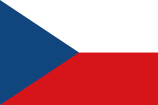 Písek, Czech Republic
Písek, Czech Republic Ilmenau, Germany
Ilmenau, Germany Schladming, Austria
Schladming, Austria
Sponsorships to
Partnerships with
Sightseeing
Historic Old Town


The tightly woven ensemble of historic buildings and houses in the Old Town (Altstadt) with its half-timbered houses and stone buildings from Romanesque (Wetzlar Cathedral) to Gothic to Renaissance and Baroque is to a great extent as it was in the late 18th century, preserved and extensively restored. Thus the great squares of Buttermarkt/Domplatz ("Butter Market/Cathedral Square"), Fischmarkt ("Fish Market"), Eisenmarkt ("Iron Market"), Kornmarkt ("Corn Market"), and the former Franziskanerhof ("Franciscan Yard"), now called Schillerplatz. From the roughly 50 noteworthy buildings, a few are listed here:
- A straight-walled half-timbered house from 1356
- The "Old Coin" (Alte Münze) at the Iron Market
- The "Roman Emperor" (Römische Kaiser) from the 15th century, a former theatre and ballroom
- The former Teutonic Knights' Court (Deutschordenshof), today a town museum
- The Lottehaus, Charlotte Buff's house
- The Jerusalemhaus in which Karl Wilhelm Jerusalem shot himself, thus attaining sad fame as Werther
- The princely Palais Papius in which is nowadays found the collection of historical furniture gathered by Dr Irmgard Freiin von Lemmers-Danforth
Also in the old outlying towns of Langgasse and Neustadt ("New Town"), connected to the Old Town by the Old Lahn Bridge (Alte Lahnbrücke), a number of historic buildings are preserved and are worth seeing. The New Town, however, has lost its mediaeval feel owing to its 20th-century four-lane streets.
The stone Alte Lahnbrücke was first mentioned in 1288. A building meant to serve as the town hall, built in the mid 14th century, was used by the Reichskammergericht as their seat and offices from 1689 to 1806, after many remodellings. Considerable remains of the town's 13th- and 14th-century fortifications are still preserved, for instance a fortress tower known as the Schneiderturm ("Tailor's Tower") or Säuturm ("Sow's Tower"), the Kalsmuntpforte ("Kalsmunt Gate" – see History) which was the town gate for the earlier suburb of Silhofen, as well as great parts of the town wall.
Wetzlar Cathedral

The Wetzlarer Dom (Wetzlar Cathedral) is one of Wetzlar's landmark buildings. Building work began on the cathedral in 1230 and is still not finished. It is the successor to a former "Church of the Saviour" consecrated in 897. The monastery and parish church was called Cathedral as of the late 17th century. This designation was accomplished during the time that the Reichskammergericht was active in Wetzlar (1693 – 1806), when the Elector-Archbishop of Trier was Monastery Provost, making the church a "Bishop's Church".
Culture
The Phantastische Bibliothek Wetzlar (Fantastic Library of Wetzlar) is one of the largest public libraries specialised in fantastic literature worldwide, it is the largest in Europe. It is generally a reference library, open for the public and scientists.
Arena Wetzlar is a multi-functional arena and is primarily used for pop concerts, shows and team handball and is the home arena of HSG Wetzlar (Handball Bundesliga).
Every summer, operas, music and drama are performed open air at the Freilichtbühne during the month-long Wetzlar Festival ("Wetzlarer Festspiele").
External links
|
||||||||||||||||||||
|
|||||||
